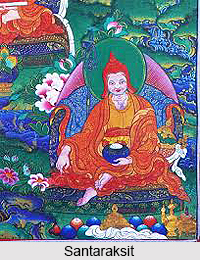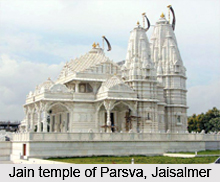 Santarakita was a well-known Indian Buddhist Brahmin in 8th century. He was one of the gems of Nalanda University of Nalanda District of Bihar. Santarakita was the son of the king of Zahor.
Santarakita was a well-known Indian Buddhist Brahmin in 8th century. He was one of the gems of Nalanda University of Nalanda District of Bihar. Santarakita was the son of the king of Zahor.
Foundation by Santarakita
Santarakita founded the philosophical school known as Yogacara-Svatantrika-Madhyamaka, which united the Madhyamaka tradition of Nagarjuna, the Yogacara tradition of Asanga and the logical and epistemological thought of Dharmakirti.
Introduction by Santarakita
Santarakita was the pioneer in the introduction of Buddhism and the Sarvastivadin monastic ordination lineage to Tibet from India which was conducted at Samye.
Ancient Texts on Santarakita
There are few historical records of Santarakita, with most available material being from hagiographic sources. Some of his history is detailed in a 19th-century commentary by Jamgon Ju Mipham Gyatso drawn from sources like the Blue Annals, Buton Rinchen Drub and Taranatha.
Early Life of Santarakita
 Santarakita was born in Rewalsar, in the modern-state of Himachal Pradesh. Santarakita was brought to Tibet at the instigation of King Trisong Detsen sometime before 767 CE. One account details his first trip as unsuccessful and he spent six years in Nepal before returning to Tibet.
Santarakita was born in Rewalsar, in the modern-state of Himachal Pradesh. Santarakita was brought to Tibet at the instigation of King Trisong Detsen sometime before 767 CE. One account details his first trip as unsuccessful and he spent six years in Nepal before returning to Tibet.
Works of Santarakita
Santarakita was once established in Tibet as a philosopher, he oversaw the translation of a large body of scriptures into Tibetan. He oversaw the construction of the first Buddhist monastery at Samye in 787 AD and ordained the first monastics there. He stayed at Samye Monastery for the rest of his life, another 13 years after its completion, and this was considered significant by Tibetans later that he stayed and did not return to India.
Philosophy of Santarakita
The philosophic views of Santarakita were the main views in Tibet from the 8th century until it was mostly supplanted by Je Tsongkhapa`s interpretation of Prasangika Madhyamaka in the 15th century. In the late 19th century, Ju Mipham attempted to promote his views again as part of the Rimé movement and as a way to discuss specific critiques of Je Tsongkhapa`s interpretation of Prasangika.
Synthesis by Santarakita
The synthesis of Madhyamaka, Yogacara, and Pramana was expounded by Santarakita in his text Madhyamakalamkara. Within the Yogacara in that text Santarakita also included the Sautrantika and "consciousness-only" Yogacara views specifically when referring to "conventional truth", one of the two truths doctrines. His view is therefore categorised as "Yogacara-Svatantrika-Madhyamaka" by later Tibetans, but he did not refer to himself that way. In his synthesis text, readers are advised to adopt Madhyamaka view and approach from Nagarjuna and Aryadeva when analysing for ultimate and to adopt the mind-only views of the Yogacarans Asanga and Vasubandhu when considering conventional truth. He also incorporates the logic approach of valid cognition and the Sautantrika views of Dignaga and Dharmakirti. Santarakita is also known for his text Tattvasamgraha. This book is a more encyclopaedic treatment of the major philosophic views of the time and survived in translation in both Tibet and China.
Death of Santarakita
It is said that Santarakita was kicked to death by a horse.



















